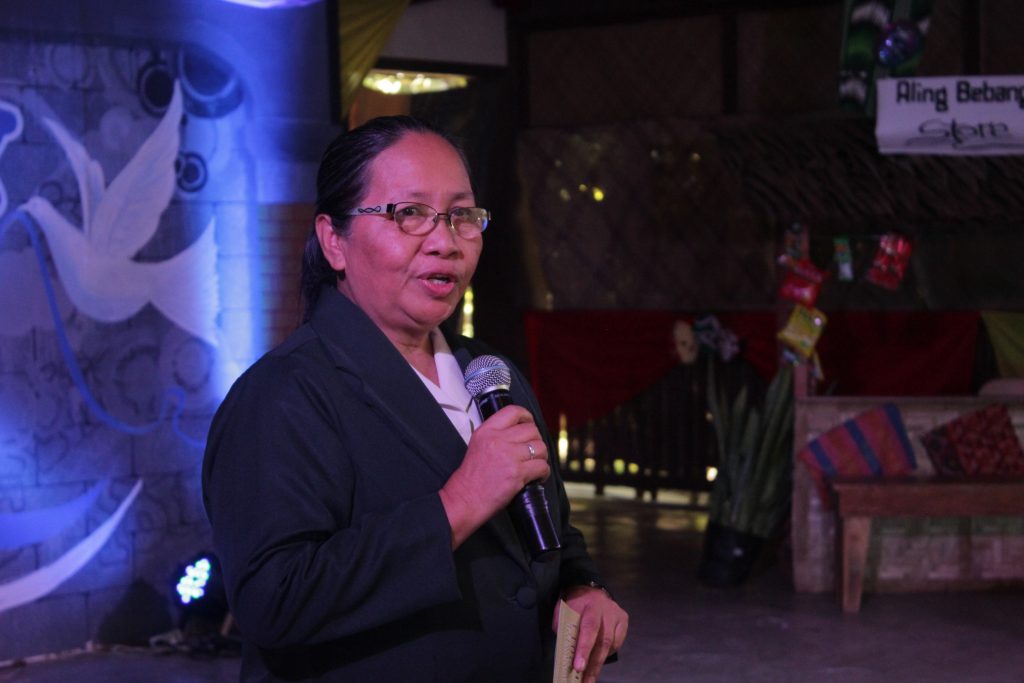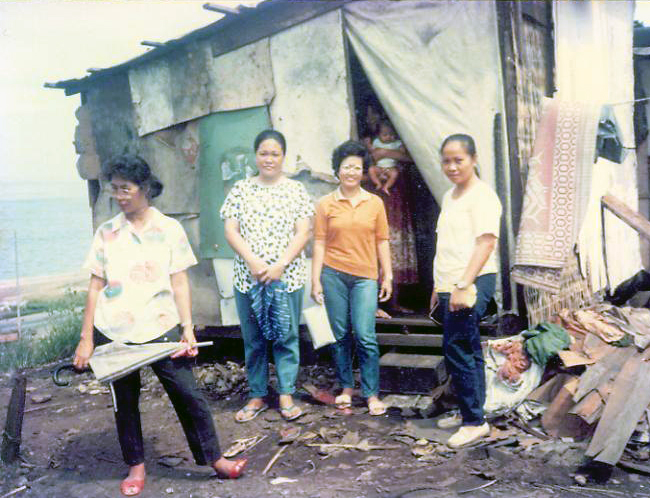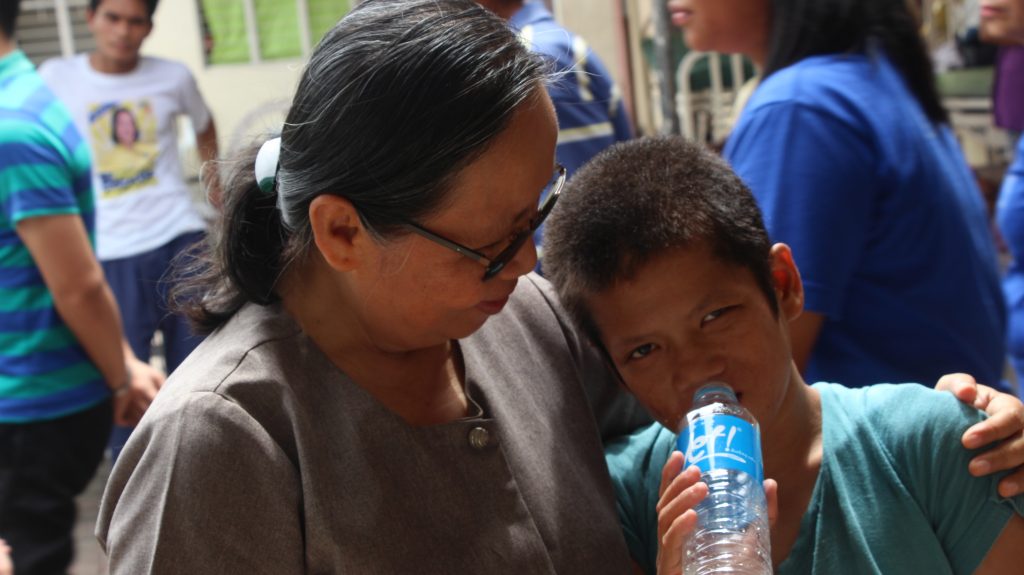By: AMINDA E. SAÑO, EDC
I remember I was more or less nine years old when for the first time, I had the opportunity fifty-six years ago to see for myself a new reality about people, places and different situations in life when my parents decided to leave our hometown in the Visayas region in order to avoid the conflict in the community that might affect or harm the future security of our family.

The first newly found place where my parents decided to stay for good was in Sirawai, Zamboanga del Norte, one of the provinces in Western Mindanao. This region is inhabited by different groups of people such as the Indigenous Tribes, Muslims and Christians who migrated from other areas of Mindanao and Visayas. As a child, situated in this new set up of living with different ethnic groups made me curious as to what were the differences between them and us. Why were there many groups of people? My parents had a very limited knowledge about other people especially the Muslims in particular. However, they remembered the story that was handed down to them by their ancestors that the Muslims are the Moros who were pirates. The Moro Pirates who came from some parts of Mindanao reached the Visayas region and raided the people living in the coastal areas. This event is related to the Moros’ resistance against the Spaniards during that time. Those Christians who were captured during the raid were brought to other places to be sold.
When we arrived in Sirawai, Zamboanga del Norte, in the early 60’s, we learned from our Christian neighbors that the Catholic Missionary Priests would visit this place once a year only to give the sacraments during Easter Celebration due to limited means of transportation with travels only by sea, and the problem was the distance to reach the place from the city of Zamboanga.
In the late 60’s, the PIME Missionary Priests arrived in Siocon, Zamboanga del Norte, which became the center of the varied missionary services of the PIME that extended to Sirawai and Sibuco areas. All of these areas were under the Diocese of Dipolog until today. The Parish Priest assigned in Sirawai was Fr. Santo di Guardo, PIME. At the age of 13, I was allowed by my parents to join the training and formation for the Catechists for Sirawai and Siocon Parish. On the other hand, I continued my secondary education in the public school. I became part of the student catechists in the school. We were known as “the little religion teachers” to the lower grade level in the school and pre-school children in the parish. Hence, I developed love for teaching every weekend.
In many occasions, Fr. Santo di Guardo, PIME taught the parishioners, and most especially the Parish Leaders not only in words but in concrete actions about the importance of the mission in the midst of poverty, injustices, and respect of people who belong to different cultures and religions. One of the organized activities he initiated was the regular visit to build friendship with the Muslims and Indigenous Tribes in the different remote areas where many are poor and needy in the Parish. There were difficulties that we encountered in this effort, but the mission has to be continued because the poor people need help not only materially, but they need to be encouraged to hope and to be assured that they are not alone in their struggle to protect and preserve the good values lived and practiced in the family and shared to others in the community.
One day, I was caught by surprise with mixed feelings, but I considered it as an answer to my heart’s desire that is to be able to finish my education in college when Fr. Santo di Guardo, my parish priest encouraged me study at Stella Maris College, Oroquieta City under a Special Intensive Training Program on Catechesis organized by the Franciscan Missionaries of Sisters (FMM). I passed the entrance exam which was a good sign that this opportunity was really meant for me. On the other hand, I have to face the reality that I have to leave my family especially my mother, who was at the time bedridden with a stage four cancer of the nerves at the lower back part of her body. But she allowed me to accept the good offer of Fr. Santo di Guardo. She also understood that this is not only for my own good but for the welfare also of my brothers and sisters, and most especially the people in the parish whom I will be serving after my graduation day. She assured me of her unceasing prayers.She passed away just after a few months I left the house on September 13, 1973. I realized that I must do good, pray to finish my studies and offer everything to God to whatever lies ahead of me in the future according to His will.

I graduated with a Bachelor of Science in Elementary Education- Religious Teaching Course (BSEED- RTC) degree at Stella Maris College, Oroquieta City in 1975. I was full of hope and ready to go back to Siocon to serve the people in different mission areas of the PIME Priests assigned in Sirawai, Sibuco and Baliguian, Zamboanga del Norte. However, an unexpected news came that Fr. Santo passed away on September 24, 1975 at the hospital in Manila, just a few months after my graduation day. It made me feel sad. This experience has motivated me to find the deeper meaning and purpose of the mission that I can do more in the Church and community with God as my guide.
Another two new PIME Priests arrived in Siocon in 1977. One is Fr. Sebastiano D’Ambra, PIME who was assigned in remote areas to give attention not only to the Christians but also the Subanen and Muslims in the area. Another missionary that came was Fr. Salvatore Carzeda, PIME who was incharge of the catechists in all parishes of the PIME. The formation for the catechists who were a priority of Fr. Salvatore with the help of the organized team of catechist coordinators.But I assisted also to the needs of the Subanen and the Muslims in the area assigned to Fr. Sebastiano. At that time, the peace and order situation was not stable in Siocon because of violence and conflict between Muslims and Christians. This kind of situation was heightened during the Martial Law period. Fr. Sebastiano initiated to live in the Muslim area to build Muslim-Christian Brotherhood, Day Care Center for pre-school children and give health assistance especially to the poor and the needy in the community. He established good relationship with the Muslim religious leaders to know more about their culture, traditions and practices, their problems and other concerns in the community. The time came when he became a negotiator between the Muslim rebels and the government in order to help build peace in the Siocon area. This effort was successful. However, Fr. Sebastiano received death threats. In one occasion, he was ambushed, yet instead of him, it was his friend who was hit by the bullet and died. Because of this situation, he had to leave the Philippines to go back to Italy.
The number of years I have spent in the different apostolates in the parish made me become spiritually mature, and the sense of mission that was inculcated in my Christian life has brought me to think about a stage of discernment for good and for my life in the future. I decided to stop working in the parish to give myself the time to pray, reflect, explore different possibilities for a few years while studying Bachelor of Science in Education (BSE) at the Ateneo de Zamboanga University.
One day I was surprised to be invited to a meeting by Fr. Sebastiano who came back from Italy after his first exile in 1981. There were other Muslim and Christian friends also in the meeting. His sharing was about his plan to organize the Silsilah Dialogue Movement in the city. I was inspired to meet new friends of Muslims and Christians who were interested to help promote the concept of dialogue presented by him. I was convinced of his ideas to build better and deeper relations between Muslims and Christians based on the spiritual approach for a sustainable Harmony and Peace in the society. I felt that I could contribute to this endeavor considering the past experiences I had when I was a catechist in the Parish and working with the PIME priest. I decided to join the group at the age of 27 years old until today, where Silsilah stands in its 38 years of existence.
I discovered many things I need to change -especially transforming my negative outlooks into a positive attitude in my relation with God, Slef, Others ,and Creation as a member of the Movement. I must admit that the prejudices and biases that had influenced me coming from my ancestors because of the history in the past was embedded in my subconscious being. I learned to gradually remove them through the process of purification of the heart, holistic healing of the painful memories in the past and by looking at history with new eyes- the eyes of God, the Source and Fountain of Dialogue.
The belief that Dialogue starts from God and brings people back to God is very important in my spiritual journey of life-in-dialogue and in rediscovering God’s style of dialoguing with humanity. Silsilah was providential in my search for meaning and vocation in life. God has allowed those events and different experiences in my life before I joined the Movement, but He did not abandon me. I believe it was His ways to prepare me for a greater purpose according to His Will. It is in Silsilah that God wants me to serve which is a mission to be fulfilled in my vocation.
Along the way, I understood that God was guiding me to make another extra mile in this mission. One day, I told Fr. Sebastiano my intention to dedicate fully my life for the mission of dialogue by forming a Christian Lay Community as a living presence among the poor and less privileged in the society. He encouraged me together with other two Christian teachers who joined me, Hermelina Buscas and Carmen Grajo to start the Emmaus Dialogue Community in 1987 in Sta. Catalina, which is at the heart of the City of Zamboanga. When Fr. Salvatore Carzeda, PIME was killed on May 20, 1992 a year after I became member of Silsilah, I was deeply pained, but it did not discourage the members of Emmaus to commit themselves to promote dialogue as a path to peace together with other members of the Silsilah Dialogue Movement.His word ‘ Padayon’ , a Cebuano word which means ‘move on’ inspiresus until today in spite of the different challenges like the violence, radicalism, terrorism, materialism, crimes against Nature- Our Common Home the Earth, and the COVID-19 Pandemic recently that the society is experiencing today. In 1997, the late archbishop of Zamboanga Bishop Carmelo D.F. Morelos, D.D. gave the recognition- Lay Association of Emmaus Dialogue Community.
On the occasion of the 33rd year anniversary of Emmaus, we became Emmaus Dialogue Movement. The members are located in the different parts of Mindanao, Manila, Italy and Canada. Another reaffirmation of Emmaus as a sign of hope and the importance of its mission for the Silsilah Dialogue Movement, the Church and humanity is the recognition for Silsilah and Emmaus as the new member of the Bounded Missionaries Families of Pontifico Intituto Missione Estere (PIME) or Pontifical Institute for Foreign Mission in 2019 after we participated in the International gathering of PIME Priests, Brothers, and Religious Sisters from different countries of the mission areas in the world.

The efforts to be a sign of hope, personal and social transformation in society is the mission of Silsilah and Emmaus with trust in God who takes always the initiative to dialogue. Nothing is impossible with Him, the center of our life.
This is the significant story of change of my life’s journey in the Silsilah Dialogue Movement and Emmaus from Mindanao to the whole world inspired by God’s Dialogue with humanity.
Padayon.
